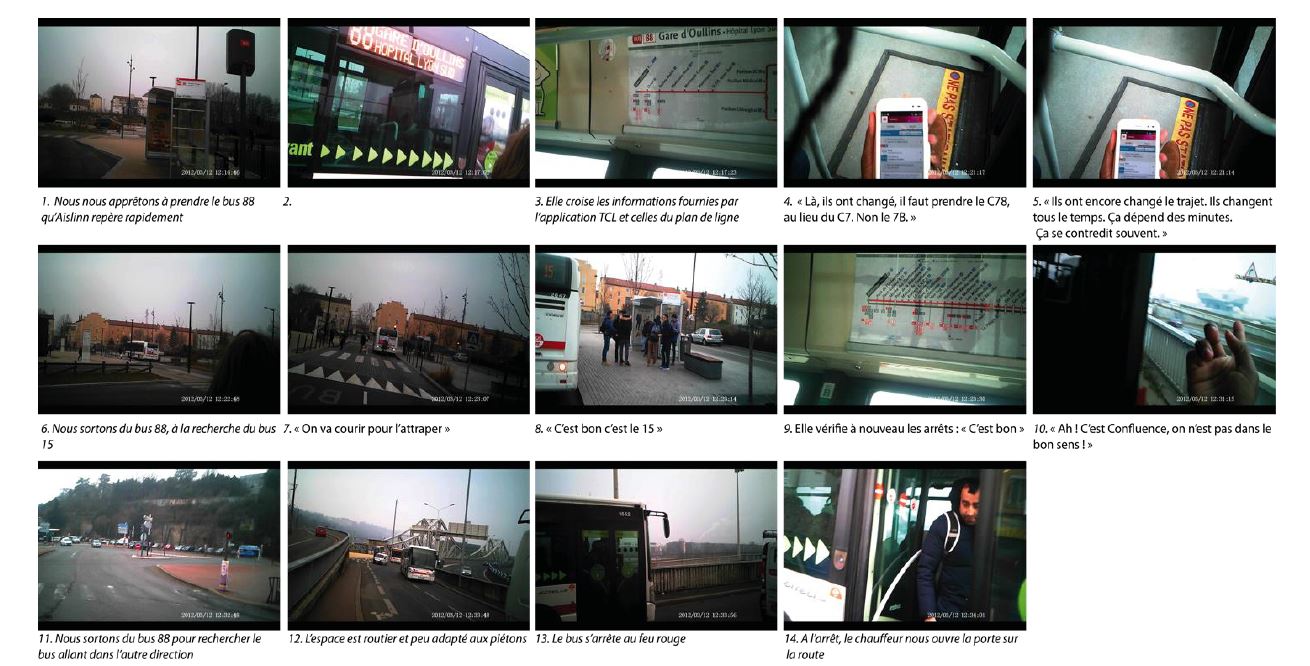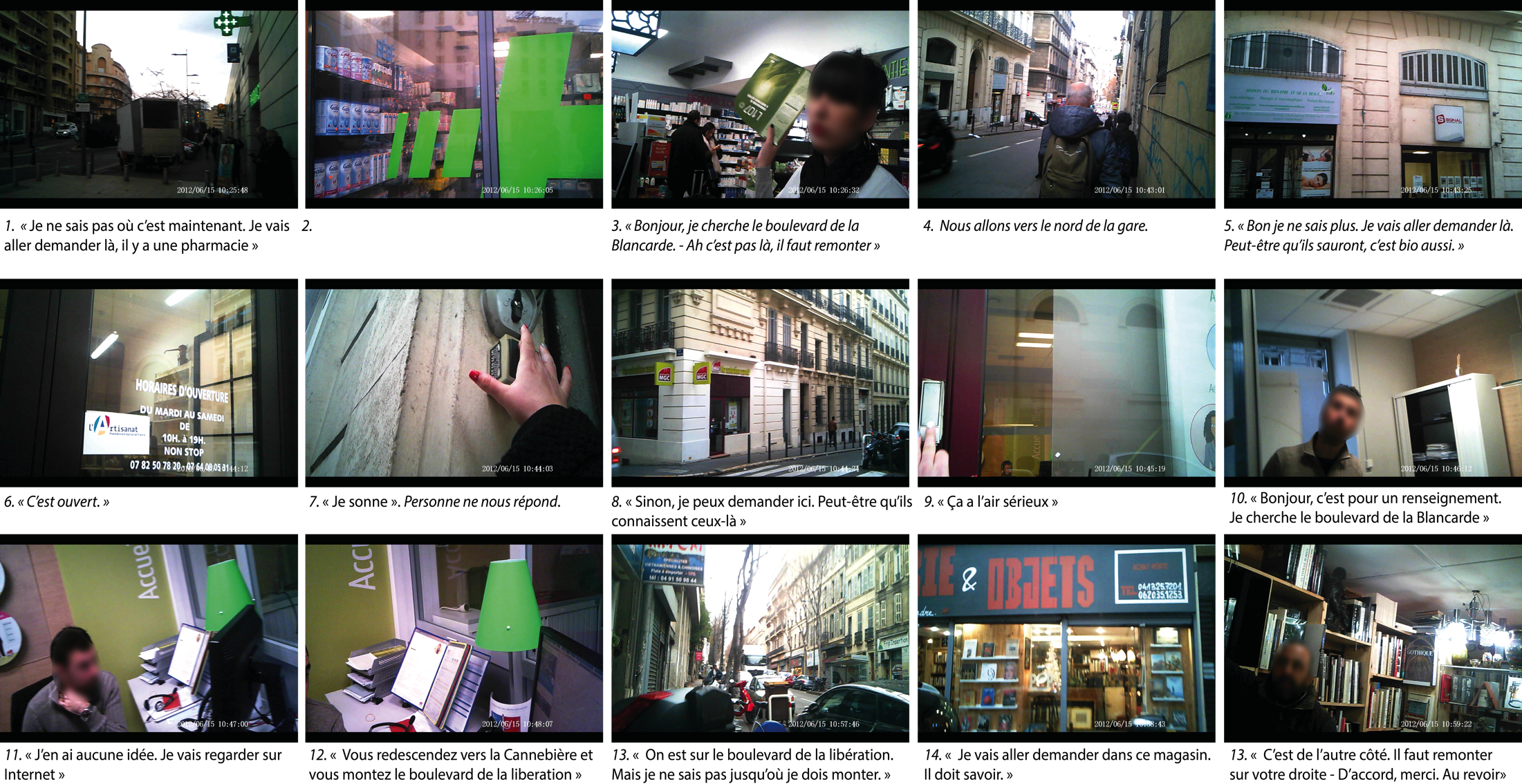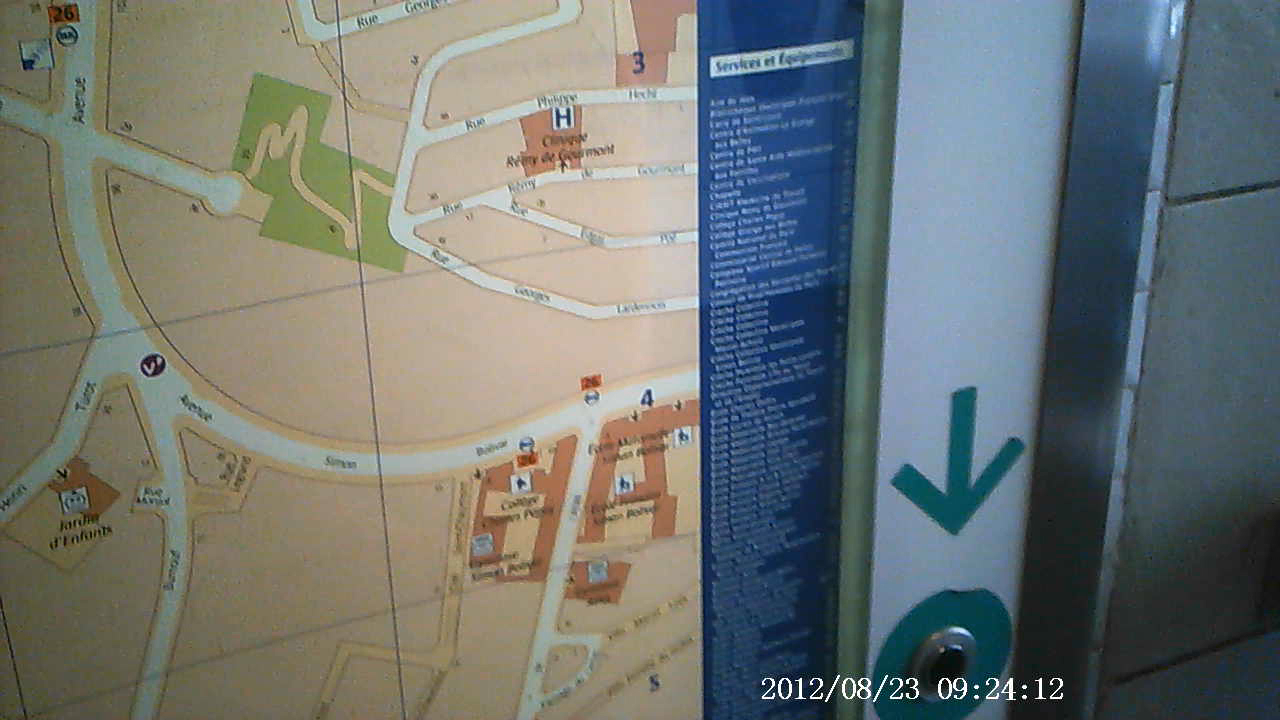
How do young people from working-class neighborhoods between the ages of 18 and 24 cope with the unfamiliar trips that they have to undertake for their social and professional integration? How do they deply different types of skills for mobility? What is the role of digital technology in their travels? Hélène-Marie Juteau tried to answer these questions by following thirty young individuals for two years and carefully observing how they undertake a trip, from planning it to completing it.
Mobility is often seen as essential to social integration, as it enables people to find a job, access different resources, meet other people, etc. Now mobility has even become an injunction: you have to “move to get by.” This is especially true for young people pursuing their social and professional integration. This is why local organizations 1 are often used to help young people in their mobility, for instance by distributing mobility cheques that allow them to renew their transport passes.
The mobilities performed in the context of social and professional integration are often exceptional mobilities involving new journeys to previously unknown places: these trips can be to complete administrative procedures, to identify a potential employer, to undertake an internship, to go to a job interview etc. The researchers studied these exceptional mobilities, which are still rarely discussed in the literature, focusing on the skills and resources that young people deploy to carry them out, especially those enabled by the use of digital technology. As they constitute a “challenge,” these mobilities are the preferred field for observing people’s ability to locate, orient and represent themselves within an unknown space for the first time.
The researchers chose the term “skills” to describe the meticulous, invisible and informal know-how observed in a given mobility situation (finding a route, adapting a route to current traffic, locating oneself in space, connecting the data found on maps to the urban landscape, etc.). The term was chosen for possessing a less normative connotation than the idea of “competences,” which can refer to specific bodies of knowledge and can easily be opposed to the idea of incompetence. It also breaks with a sometimes implicit hierarchy of mobile and digital practices and allows us to better understand people’s abilities in all their diversity.
In partnership with local organizations, the researchers followed 30 young people aged 18 to 24 looking for work, living in working-class neighborhoods of Marseille, Villeurbanne and Saint-Denis.
They analyzed how individuals use their skills and resources, particularly smartphones and mobility applications, to familiarize themselves with and leverage the public space and modes of transportation as they travel. To do this, they used an ethnographic approach combining filmed trips with commentary and semi-structured interviews. The young people were accompanied by researcher Hélène-Marie Juteau throughout their trip. She observed how they prepare their journey (figuring out the destination, choosing an itinerary, etc.) and then they wore glasses equipped with a little camera between the eyes so as to film what they were looking at: surroundings, people, smartphone screen, etc.

The camera-glasses subjectively filmed the trip while the participant commented on it in real time for the researcher. This allowed her to record and analyze in detail how young people performed their trips, by observing how they went back and forth between their smartphone and the urban environment, or by finely analyzing their use of mobile applications during the trip and connecting it to what they commented on at the time. This original methodology provided very faithful insights into the mobility experience of the young people surveyed.
Although all the subjects come from working-class neighborhoods and are pursuing a process of social and professional integration, their situations are all very different. Aged between 18 and 24, they have varying levels of academic achievement, ranging from graduating middle-school to having completed two years of higher-education. Their access to the various resources at their disposal for their integration process varies according to the financial means and support of their parents. For example, some participants have a public transport pass or have a driver's license or a car, while others have limited access to transportation.
There are also inequalities in their access to digital resources. In terms of equipment almost all of the research participants had a smartphone. However, some enjoyed stable Internet connections while others endured interruptions of varying regularity and length, due to a lack of mobile data, lack of means to buy more data, etc. This creates subjective digital geographies that rely on network of family and friends (loaning equipment when lacking connections, using the Wi-Fi at home or at a friend’s place) and on places that function as connected urban resources (McDonald's, KFC, libraries, shopping malls, etc.). Access to digital resources for social and professional integration also depends on their understanding and proficiency with digital applications (Google Maps, transport websites) and traditional online job search tools (Employment Centre website, Indeed, etc.); their skills in this regard vary greatly depending on their previous professional experiences, the support they’ve received, their familiarity with the tools, etc.
Their social resources also vary and depend in particular on their ability to use networks of strong ties and weak ties. Strong ties refer to family and friends that they benefit from to varying degrees. Weak ties correspond to other kinds of ties (acquaintances, professional network, etc.); some participants had built a network of weak links through past training or work experience, while others had a much smaller or non-existent network, which is a handicap for their integration process.
Access to these social and family networks influences their experience of mobility. Some travelled extensively in their childhood and adolescence with their parents or peers, some even experienced migration; as such they learned to move outside the familiar space of their neighborhood, sometimes even to a foreign country with unfamiliar social, territorial or linguistic codes. Meanwhile, some of the respondents weren’t used to travelling far from their neighborhood. They might correspond to a category identified by Eric Le Breton as being “insular,” which refers to socially excluded individuals whose mobility is limited to familiar spaces which are both reassuring and marginalizing.
There are different ways of combining these various resources and making up for the lack of access to some of them. Some participants have a good understanding of the job market, know how to move easily in unknown spaces - especially young migrants - and have access to a digital connection, but some prefer to call upon their network of strong ties by asking a friend or relative if they know how to get to a particular place. Others have access to fewer resources but manage to circumvent these obstacles by tinkering with tools they already know how to use: for example, if they struggle with traditional job search web sites, they hijack the conventional use of social networks like Snapchat to share their integration project with their contacts and collect information about job offers. The obstacles to accessing digital resources are also an opportunity to mobilize social resources: for example, during their trips, some participants who lacked a mobile connection made up for this by asking passers-by or shopkeepers for directions.
However, a few participants were unable to leave their familiar space, both socially and geographically. They don’t know how to use the traditional job search spaces and are reluctant to leave their neighborhood or their relatives’ neighborhood. During their travels, because they have poor digital skills and struggle to ask strangers for directions, they depend, to varying degrees, on their relatives who guide them.
The research also established a typology of the forms of hybridization performed by young people during their trips. Hybridization refers to the interconnecting of information from different sources: in-situ information found in a physical space, digital information provided by digital devices in real time or with a delay, and interpersonal information provided remotely or face-to-face.
Six forms of hybridization were identified. These include digital hybridization based on a roadmap, hybridization through travel sociability and hybridization by clever digital tinkering.
Mobile hybridization based on a roadmap, which concerns 12 out of the 30 young participants, relies on an itinerary - or roadmap - provided by mobility applications (transportation apps, Google Maps, etc.). All participants in this category have access to a mobile data plan, which allows them to leverage these resources while on the move. Their skills consist of comparing and combining the real-time information they receive on these applications (e.g. bus number, directions, number of stations) with the urban signage system (e.g. the line plan inside the bus) or with surrounding landmarks they see (e.g. the town hall).

The resynchronization effort with the digital roadmap
Hybridization through travel sociability concerns 7 out of the 30 young participants; these young individuals have little experience in terms of mobility. They have limited or unreliable access to modes of transport (no public transport card, old car); some don’t have an Internet data plan. During their trips, they use face-to-face sociability skills. They know how to select a contact person they deem most suitable to ask for directions, for example shop-owners working in the care industry (pharmacy, insurance, etc.), or conversely how to avoid people with the same skin color as them (black) because “they may speak to me in a language that I won’t understand.” At the same time, they sometimes mobilize their network of strong ties by calling their relatives during the trip, to be guided remotely. Their skills are then deployed in the hybridization between the information received from a contact person or a relative (turning at a particular street, after passing by a specific shop, etc.) and those they find in-situ (street name, finding the shop that serves as a landmark, etc.).

The methodical selection of the resource facility during the trip
A third form of hybridization is one that is constructed by digital tinkering. It concerns 4 out of the 30 young participants. It is observed in young people who don’t have access to a mobile plan or have poor access. They overcome these deficiencies with clever digital tinkering: they prepare their journey at length, recording the necessary information before the trip by copying the itinerary found on a desktop computer or by taking a picture of a map. Then, they make do with the resources they find on site by comparing the information they recorded in advance with a city map found on a bus shelter while on the move, which they also take a picture of to save the information. Their skills include creating resources that they can draw upon in a mobility situation, retaining the information found before the trip, and combining these resources with those they find in-situ.

The picture of the city map
The research also shows that the ability of young people to complete a journey, from the choice of destination and purpose of the trip (dropping off a CV, identifying an employer, etc.) to its completion, clearly does not depend only on their ability to mobilize digital or social resources to complete their journey: the clarity of their social and professional integration project is also decisive.
Some young people have a specific professional project and their trips are performed in direct service of this project. Others have a professional project but its realization is hampered by economic or administrative difficulties (right of residence for example). Finally, some young people struggle to establish a professional project; lacking self-confidence and without a precise goal, they struggle to plan trips, not knowing where to go and what for.
As a result, in the current context with a very pervasive injunction to mobility, research leads us to downplay the place of mobility in the success of a social and professional integration process, as it depends first and foremost on the clarity of a person’s professional project - or at least the one they allow themselves to have.
While mobility is highly valued as a facilitator of professional integration and digital tools are often seen as a universal resource enabling it, research shows significant inequalities in people’s ability to access and master digital resources related to mobility and the job search. These inequalities are compounded by unequal access to social resources and means of transport. While many young people can rely fully on digital technology, others compensate for their limited access or poor skills by tinkering with the tools or mobilizing social ties. Consequently, despite the strong development of applications that help with mobility, research shows that digital technology is not necessarily essential to the performance of unfamiliar trips, and that social resources are sometimes preferred.
The research finely describes the varied skills that young people deploy during a journey by carefully hybridizing the information gathered from different channels with that of their physical surroundings. This complex exercise gives them autonomy to get out of their familiar environment (social and territorial). Conversely, those who depend exclusively on their relatives fail to go beyond their familiar spaces.
However, the value of this autonomy must be put into perspective: mobility is useful for the integration process if one has a project that gives them clear objectives both in the social space (professional project) and in the physical space (trips that are in service of this project).
Download the full report (In french only)
Augoyard J.-F., Pas à Pas Essai sur le cheminement quotidien en milieu urbain , Éditions À la Croisée, coll. Ambiances Ambiance, 1ère édition 1979, rééd. 2010, 224 p.
Boullier D., « Habitèle : une nouvelle enveloppe pour commuter, notre téléphone portable », in Urbanisme, décembre 2010
Grosjean M., Thibaud J.-P. (dir), L’espace en urbain en méthode, Éditions Parenthèses , coll. « Eupalinos », 2008, 214 p.Ingold T, The perception of the environment: essays on livelihood, dwelling and skill, London: Routledge, 2000, 480 p.
Ingold, T., « Footprints through the weather-world: walking, breathing, knowing », in Journal of the Royal Anthropological Institute, vol 16, no. Supplement s1, 2010, p. S121-S139.
Joseph I., Boullier D., Guillaudeux V., Gare du nord mode d’emploi, Programme de recherches concertées sur la gare du Nord , Développement-Prospective RATP, 1994, 443 p.
Juteau H.-M., Le piéton et son GPS. Une exploration urbaine de Nantes en parcours commentés , mémoire de master 2 DYATER, ESO-Rennes, 2014
Kaufmann V., Retour sur la ville Motilité et transformations urbaines , PPUR, coll. « Espace en société », 2014, 200 p.
Le Breton E., Bouger pour s’en sortir. Mobilité quotidienne et intégration sociale , Armand Colin, 2005, 247 p.
Licoppe C., Inada Y., "Geolocalized Technologies, Location Aware Communities and Personal Territories " : The Mogi Case", in Journal of Urban technology 15(3), 2008, p. 5-24.
Licoppe, C., Zouinar, M. (dir.), « Les usages avancés du téléphone mobile », in Réseaux 27 (156), 2009, 292 p.
Lynch K., The image of the city , The MIT Press, 1960, 194 p.
Massey D., For Space, London : Sage, 2005, 232 p.
Moser G. et Weiss K., Espace de vie Aspects de la relation homme-environnement , Armand Colin, 2003, 395p
Schehr S., La vie quotidienne des jeunes chômeurs , Puf, 296 p., 1999
Sheller M., Urry J., « The new mobilities paradigm », in Environment and Planning, A 2006, vol. 38, p. 207-226
Wenglenski S., « Regards sur la mobilité au travail des classes populaires. Une exploration du cas parisien », in Cahiers Scientifiques du Transport, n° 49, 2006, p. 103-127
1 Local organizations are organizations that support young people between the age of 16 and 25 to promote their social and professional integration.
For the Mobile Lives Forum, mobility is understood as the process of how individuals travel across distances in order to deploy through time and space the activities that make up their lifestyles. These travel practices are embedded in socio-technical systems, produced by transport and communication industries and techniques, and by normative discourses on these practices, with considerable social, environmental and spatial impacts.
En savoir plus xThe mobilities paradigm is a way of seeing the world that is sensitive to the role of movement in ordering social relations. It serves to legitimize questions about the practical, discursive, technological, and organizational ways in which societies deal with distance and the appropriate methods for their study.
En savoir plus xTo cite this publication :
Christian Licoppe et Hélène-Marie Juteau (11 March 2019), « Mobility and job hunting: a digital barrier? », Préparer la transition mobilitaire. Consulté le 09 January 2025, URL: https://forumviesmobiles.org./en/project/3143/mobility-and-job-hunting-digital-barrier

Projects by Forum Vies Mobiles are licensed under a Creative Commons Attribution-NonCommercial-ShareAlike 3.0 France License.
Permissions beyond the scope of this license may be available at contact.
Other publications